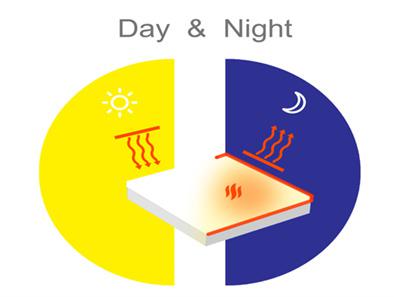当前位置:
X-MOL 学术
›
Polym. Eng. Sci.
›
论文详情
Our official English website, www.x-mol.net, welcomes your
feedback! (Note: you will need to create a separate account there.)
Fabrication of polymeric solar thermal fuel composite for solar energy storage applications
Polymer Engineering and Science ( IF 3.2 ) Pub Date : 2021-08-24 , DOI: 10.1002/pen.25790 Armaghan Ehsani Telgerafchi 1 , Milad Mehranpour 1 , Hossein Nazockdast 2
Polymer Engineering and Science ( IF 3.2 ) Pub Date : 2021-08-24 , DOI: 10.1002/pen.25790 Armaghan Ehsani Telgerafchi 1 , Milad Mehranpour 1 , Hossein Nazockdast 2
Affiliation

|
Solar energy storage and conversion have remained significant global challenges. This article discusses how to fabricate a polymeric solar thermal fuel (P-STF) composite with unique thermal storage abilities. In this regard, we aim at developing a novel method for dispersing multi-walled carbon nanotubes (MWCNTs) functionalized with azobenzene molecules (modified azobenzene molecules) in ethylene-vinyl acetate (EVA). The modification of azobenzene (functionalization) enhances the energy storage density of AZO molecules, and the addition of fillers (MWCNT) leads to the production of the P-STF composite with the potential to store and convert solar energy to thermal energy. The differential scanning calorimetry (DSC) test verifies the P-STF composite's capacity to absorb solar energy and release it as heat. Thus, the uncharged nanocomposites required heat energy at the melting point temperature of EVA (Enthalpy 18.392 J/g). However, the EVA-AZO-MWCNT 10% and EVA-AZO-MWCNT 5% nanocomposites released heat energy rather than requiring it to melt with enthalpy −37.6526 and −1.2609 J/g, respectively, which indicates the heat release in the P-STF composite. Moreover, oscillatory shear rheological measurement (RMS) and field emission scanning electron microscopy (FESEM) demonstrate that modified azobenzene (MWCNT-AZO) is well dispersed in the polymer matrix (EVA).
中文翻译:

用于太阳能存储应用的聚合物太阳能热燃料复合材料的制造
太阳能存储和转换仍然是重大的全球挑战。本文讨论了如何制造具有独特储热能力的聚合物太阳能热燃料 (P-STF) 复合材料。在这方面,我们旨在开发一种将偶氮苯分子(改性偶氮苯分子)官能化的多壁碳纳米管(MWCNT)分散在乙烯-醋酸乙烯酯(EVA)中的新方法。偶氮苯的改性(功能化)提高了偶氮分子的储能密度,填料(MWCNT)的加入导致了P-STF复合材料的产生,该复合材料具有储存太阳能并将太阳能转化为热能的潜力。差示扫描量热法 (DSC) 测试验证了 P-STF 复合材料吸收太阳能并将其作为热量释放的能力。因此,不带电荷的纳米复合材料在 EVA 的熔点温度(焓 18.392 J/g)需要热能。然而,EVA-AZO-MWCNT 10% 和 EVA-AZO-MWCNT 5% 纳米复合材料释放热能,而不是要求它以 -37.6526 和 -1.2609 J/g 的焓熔化,这表明 P- STF复合材料。此外,振荡剪切流变测量 (RMS) 和场发射扫描电子显微镜 (FESEM) 表明,改性偶氮苯 (MWCNT-AZO) 很好地分散在聚合物基质 (EVA) 中。这表明 P-STF 复合材料中的热释放。此外,振荡剪切流变测量 (RMS) 和场发射扫描电子显微镜 (FESEM) 表明,改性偶氮苯 (MWCNT-AZO) 很好地分散在聚合物基质 (EVA) 中。这表明 P-STF 复合材料中的热释放。此外,振荡剪切流变测量 (RMS) 和场发射扫描电子显微镜 (FESEM) 表明,改性偶氮苯 (MWCNT-AZO) 很好地分散在聚合物基质 (EVA) 中。
更新日期:2021-08-24
中文翻译:

用于太阳能存储应用的聚合物太阳能热燃料复合材料的制造
太阳能存储和转换仍然是重大的全球挑战。本文讨论了如何制造具有独特储热能力的聚合物太阳能热燃料 (P-STF) 复合材料。在这方面,我们旨在开发一种将偶氮苯分子(改性偶氮苯分子)官能化的多壁碳纳米管(MWCNT)分散在乙烯-醋酸乙烯酯(EVA)中的新方法。偶氮苯的改性(功能化)提高了偶氮分子的储能密度,填料(MWCNT)的加入导致了P-STF复合材料的产生,该复合材料具有储存太阳能并将太阳能转化为热能的潜力。差示扫描量热法 (DSC) 测试验证了 P-STF 复合材料吸收太阳能并将其作为热量释放的能力。因此,不带电荷的纳米复合材料在 EVA 的熔点温度(焓 18.392 J/g)需要热能。然而,EVA-AZO-MWCNT 10% 和 EVA-AZO-MWCNT 5% 纳米复合材料释放热能,而不是要求它以 -37.6526 和 -1.2609 J/g 的焓熔化,这表明 P- STF复合材料。此外,振荡剪切流变测量 (RMS) 和场发射扫描电子显微镜 (FESEM) 表明,改性偶氮苯 (MWCNT-AZO) 很好地分散在聚合物基质 (EVA) 中。这表明 P-STF 复合材料中的热释放。此外,振荡剪切流变测量 (RMS) 和场发射扫描电子显微镜 (FESEM) 表明,改性偶氮苯 (MWCNT-AZO) 很好地分散在聚合物基质 (EVA) 中。这表明 P-STF 复合材料中的热释放。此外,振荡剪切流变测量 (RMS) 和场发射扫描电子显微镜 (FESEM) 表明,改性偶氮苯 (MWCNT-AZO) 很好地分散在聚合物基质 (EVA) 中。











































 京公网安备 11010802027423号
京公网安备 11010802027423号